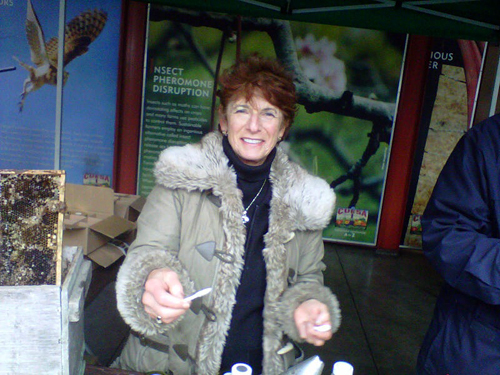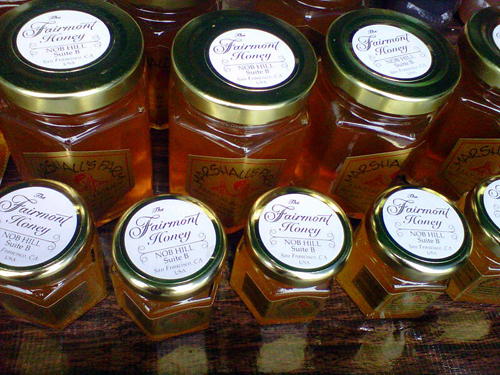Happy spring! The vernal equinox, daylight savings time, and the Jewish holiday of Purim may all be upon us, but brrrr! With umbrella-destroying winds, tornado watches along the coast, and socks-drenching rain, it's feeling much more like winter than balmy spring. Oh well--remember all those sunbathing days we got back in January?
Like most of us, bees prefer to stay inside where it's warm and dry on days like this, snuggling together in a big bee-ball to keep themselves, and especially their queen, nice and toasty. But for humans, the show must go on, and so CUESA's honey celebration at the San Francisco Ferry Plaza Farmers' Market on Saturday, March 19th went on even in the teeth of blowing rain. Once a month from February through November, CUESA will be hosting a celebration for a different fruit, vegetable, or product, featuring tastings, ask the farmer (or producer) sessions, and a variety of cooking demonstrations by local chefs and cookbook authors. Last month was citrus; this month, for the first time, was honey.
First up behind the counter was Margo True, food editor of Sunset magazine and the author (along with her staff) of Sunset's latest book, The One-Block Feast. The book, which comes out next week, came out of a series of homesteading projects undertaken by Sunset over the last couple of years. "We wanted to get back to the Lane brothers' original vision for Sunset, which was as a laboratory for Western living," said True. With a spacious garden, room for bees and chickens, the ability to get a "milk share" from a cow living at a nearby farm, and lots of kitchen room for testing, True and her team set out to see if they could make or source everything--even flour and sea salt--from as close to the magazine's Menlo Park campus as possible. The results were sometimes spectacular, sometimes frustrating, but all of it got incorporated into the book. True tried to be as honest as possible, promising that they "definitely wrote about what bombed," too.
However, on this gray morning, True was here to show off two recipes that promise big payback for not too much effort. A custard-based honey ice cream, made with honey from the magazine's own hives, had a suave, salted-caramel edge, thanks to a drizzle of honey on top and a sprinkle of sea salt. It's more lusciously creamy than sweet, but the honey flavor still comes through. Even though it was hardly ice cream weather, the crowd snapped up every sample and scraped the cups clean.
Next came strawberry jam, made of nothing more than ripe early-season berries, honey, and a dash of lemon juice. Rather than cook it on the stovetop, where the direct heat could scorch the mixture, True spread out her chunky berry puree in a thin layer on a baking sheet, then revealed her secret: a long, gentle bake in a slow oven, which would gently condense it down while preserving the berries' ripe flavor. Spread on slices of Acme bread, the finished jam did taste remarkably fresh, with a soft consistency somewhere between jam and compote, perfect for a yogurt parfait topped with granola and a handful of fresh berries.

